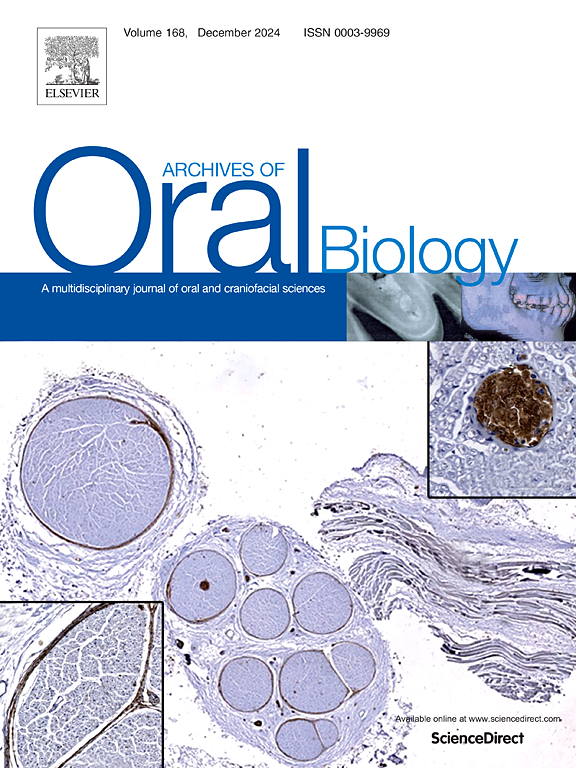Effect of CD10-positive cells on osteogenic differentiation of human maxillary/mandibular bone marrow-derived mesenchymal stem cells
IF 2.2
4区 医学
Q2 DENTISTRY, ORAL SURGERY & MEDICINE
引用次数: 0
Abstract
Objective
This study was aimed at investigating the effect of CD10-positive cells within the maxillary/mandibular bone marrow-derived mesenchymal stem cells (MBMSCs) on osteogenic differentiation of MBMSCs.
Design
CD10 expression in iliac bone marrow-derived MSCs (IBMSCs), MBMSCs, and gingival fibroblasts was measured using flow cytometry. The osteogenic potential of 19 MBMSC lines was evaluated, and based on it, they were classified into osteogenic-High and osteogenic-Low groups. The percentage of CD10-positive cells in each group was compared. Effect of coculturing gingival fibroblasts and CD10-positive cells on the osteogenic potential of MBMSCs was also assessed. Expression of tissue inhibitor of metalloprotease-1 (TIMP-1) in osteogenic-High and osteogenic-Low MBMSCs was measured using quantitative real-time polymerase chain reaction, western blotting, and enzyme-linked immunosorbent assay. The molecular mechanisms underlying the regulation of osteogenic differentiation in MBMSCs were investigated.
Results
CD10 was not expressed in IBMSCs, but was highly expressed in fibroblasts. In MBMSCs, the CD10-positivity rate varied considerably between cells. MBMSCs with a high-CD10 positivity rate showed low osteogenic potential. Coculture with fibroblasts or CD10-positive cells reduced the osteogenic potential of MBMSCs. TIMP-1 was highly expressed in CD10-positive cells, and osteogenic-Low MBMSCs showed significantly higher TIMP-1 expression compared with osteogenic-High MBMSCs. β-catenin signaling was suppressed in osteogenic-Low MBMSCs.
Conclusion
This study revealed that TIMP-1 secreted from CD10-positive cells may be involved in the suppression of the osteogenic potential of MBMSCs by contamination with CD10-positive cells. This finding provides important insights for developing bone regeneration therapies using MBMSCs.
CD10 阳性细胞对人上颌骨/下颌骨骨髓间充质干细胞成骨分化的影响
设计 使用流式细胞术测量髂骨骨髓间充质干细胞(IBMSCs)、MBMSCs和牙龈成纤维细胞中CD10的表达。评估了 19 个 MBMSC 株系的成骨潜能,并据此将它们分为成骨性高组和成骨性低组。比较了各组 CD10 阳性细胞的百分比。还评估了牙龈成纤维细胞和 CD10 阳性细胞共培养对 MBMSCs 成骨潜能的影响。使用定量实时聚合酶链式反应、Western 印迹和酶联免疫吸附试验测定了成骨性高和成骨性低 MBMSCs 中组织金属蛋白酶抑制剂-1(TIMP-1)的表达。结果 CD10 在 IBMSCs 中不表达,但在成纤维细胞中高表达。在 MBMSCs 中,不同细胞的 CD10 阳性率差异很大。CD10 阳性率高的 MBMSCs 成骨潜能低。与成纤维细胞或 CD10 阳性细胞共培养会降低 MBMSCs 的成骨潜能。TIMP-1在CD10阳性细胞中高表达,与成骨性高的MBMSCs相比,成骨性低的MBMSCs的TIMP-1表达明显更高。该研究揭示,CD10 阳性细胞分泌的 TIMP-1 可能参与了 CD10 阳性细胞污染对 MBMSCs 成骨潜能的抑制。这一发现为利用 MBMSCs 开发骨再生疗法提供了重要启示。
本文章由计算机程序翻译,如有差异,请以英文原文为准。
求助全文
约1分钟内获得全文
求助全文
来源期刊

Archives of oral biology
医学-牙科与口腔外科
CiteScore
5.10
自引率
3.30%
发文量
177
审稿时长
26 days
期刊介绍:
Archives of Oral Biology is an international journal which aims to publish papers of the highest scientific quality in the oral and craniofacial sciences. The journal is particularly interested in research which advances knowledge in the mechanisms of craniofacial development and disease, including:
Cell and molecular biology
Molecular genetics
Immunology
Pathogenesis
Cellular microbiology
Embryology
Syndromology
Forensic dentistry
 求助内容:
求助内容: 应助结果提醒方式:
应助结果提醒方式:


